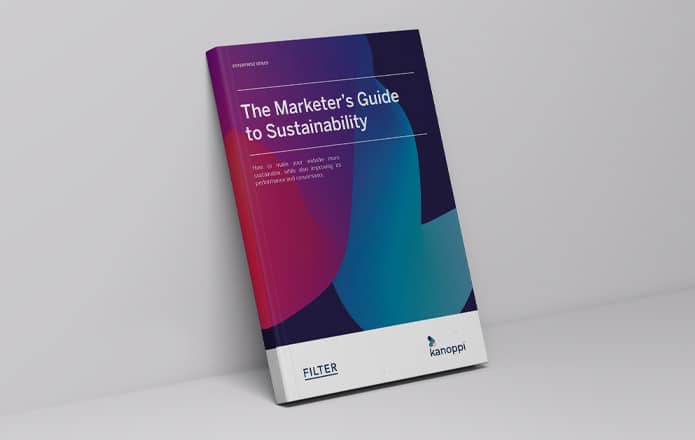
In this article, we’ll explain what a CDN is, how it works, and the benefits you could gain from taking this approach.

Marketers are always looking for ways to improve the speed and user experience (UX) of their websites. After all, the faster your website, the better it will be at attracting and retaining customers.
One method for providing a faster, more seamless experience to your site visitors is through a content delivery network (CDN). Not only does this improve UX, it also significantly reduces the carbon footprint of your website.
When someone visits a page on your website, the data that constitutes that web page has to be transmitted from your hosting server to the web browser on that visitor’s device.
As an example, if the data centre hosting your servers is based in the UK, and your website visitor is in Australia, the physical distance between the server and the device will cause a slower page load time than your users typically expect.
A content delivery network (CDN) is a great solution to this problem. These are secondary servers, hosted in international locations, designed to deliver your website’s data to visitors abroad more locally.
CDNs are a separate aspect of web hosting, enabled by a wide range of servers spread out across the globe. This more efficient approach reduces bandwidth by compressing and delivering static content from the nearest server to each visitor.
If you’re not using CDNs to optimise your site’s UX for an international audience, you’re likely losing some visitors to frustration caused by slow loading times.
A CDN stores a cached copy of your website so it doesn’t have to load the data from scratch whenever it’s called upon. When someone located in a different country visits your site, your nearest CDN will transmit the data to their browser. As a result, they receive an optimum load speed, which removes the frustration from that user’s experience.
A key area of this efficiency is in images and video content, which are some of the biggest causes of slow page load speeds for websites. CDNs are programmed to automatically optimise and compress media files. They also deliver images and video in the most appropriate formats and sizes based on each individual visitor’s device.
CDNs also distribute the load on the servers across a range of locations, preventing server congestion and maintaining maximum speeds.
If someone abroad visits your website, and your data has to be transmitted over a large physical distance, this uses up more energy. That causes your server to emit more greenhouse gases than it should by digital sustainability standards.
Having a CDN transmit your site’s data to those visitors from a server more local to them will significantly reduce your site’s carbon footprint.
The CDN’s caching approach also reduces the number of requests sent to your main server, which minimises the amount of data transmission and reduces the energy usage.
A common concern for many businesses when looking into CDNs with security. Due to their nature, though, CDNs often offer additional layers of security and protections.
For example, CDNs offer particularly robust defence against distributed denial of service (DDoS) attacks.
This is because the CDN sits between the end-users and your primary server. That helps add an extra layer of protection from security threats before they’re able to reach the server storing your web platform and your data.
Energy efficiency is one of the primary reasons CDNs exist. It’s crucial to proactively reduce your website’s carbon footprint, and the web hosting services you use play a big role in that.
However, you should still carry out due diligence to ensure your CDN providers also use environmentally-friendly “green hosting” practices. Most CDN services are sustainable and energy-efficient, but it’s still important to check this when evaluating your options.
One of your biggest questions will probably be regarding the cost implications of using a CDN. If something provides far greater speed and performance, you’d usually assume it comes at a high cost.
Thankfully, that’s not the case with CDNs. Not only are they energy-efficient, they’re also cost-effective. While CDNs do obviously come with a cost, they’ll usually help you save money on monthly data transmission that outweighs the price of the service.

Download our FREE guide to digital sustainability to access key insights, created in collaboration with the industry experts behind Kanoppi.
Clearly, CDNs will help you improve the speed and performance of your website, while
taking a much more sustainable approach to web hosting. As a result of those benefits, you’ll begin to see a wealth of other advantages begin to have a positive impact on your business.
From a performance perspective, providing a great UX to your global audience will:
And, sustainability-wise, this will present opportunities for:
There are a lot of reasons to adopt a CDN, and it’s easy to appreciate why this approach has risen in popularity in recent years.
But, even if you do begin using a CDN, your website will still be emitting greenhouse gases. In fact, you may be surprised to hear that the digital sector is responsible for more emissions than the aviation industry.
Why is this important? Well, there’s a direct correlation between websites with big carbon footprints and slow websites with poor UX. And that’s without even mentioning the obvious duty we have to protect the environment.
You can learn more about how digital sustainability can help you create a more performant website in our latest guide, The Marketer’s Guide to Sustainability.
This guide explores the relationship between sustainability and website performance in much more detail. It will also teach you:
Here is a list of helpful resources to support you on your journey to becoming more sustainable.